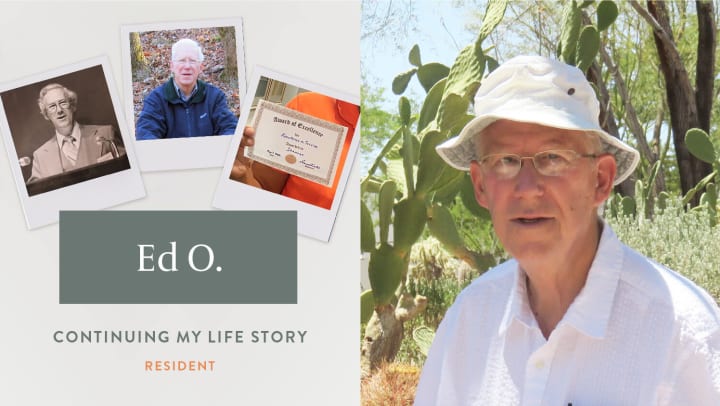You are a scientist and educator. You served as Supervisor of Science at St. Louis Public Schools, what did that job entail?
Hands-on science is my hallmark. I worked with students as they found answers to questions about science and nature. As the Supervisor of Science at the St. Louis Public Schools, I oversaw science education for kindergarten through twelfth grade. During my career, I helped write 30 different science books. I was active in the National Science Teaching Association, and I served as the District Director for Missouri, Illinois and Iowa. Eventually, I became president of the association. I’ve traveled the country sharing science knowledge with teachers, and I once spent a summer in Japan giving talks to teachers about science education in the U.S.
You’ve spent your life studying nature and teaching science. What drives you?
I want to open up people’s eyes to what’s in front of us. I want to encourage people to take a nature walk. You can take a nature walk with your local conservation society. You might smell a pine tree or see an ant trail crossing your path. You might see an interesting insect crawling across the ground. It’s never too late to open your mind to nature.
What inspires you most about science and nature?
Earth is a chunk of stuff floating in the atmosphere and the whole world revolves around science. Everything that happens on Earth is unique to our planet. On other planets there are entirely different things occurring. Here, we are so fortunate to have so many living things that are just fascinating.
In the business world we have intricate things in shops and factories. But the same sort of principle is going on in the world of nature. There are interactions between the soil and the plants, and between the creatures and the plants. Each living thing impacts another. It’s the interaction between different living things that interests me.
Woods are your favorite places to be. Why?
I’ve always enjoyed being in the woods and seeing what would jump around -- frogs, toads and insects.
Many people find the woods intimidating, can you speak to that?
Many people are afraid to even step into the woods. They think creatures are going to come and get them and bite them. I like to remind people that these beings are living their lives and you’re just watching what they’re doing.
When I was teaching field biology, the students were deathly afraid of what was going to come out when we were in the woods in Forest Park, Missouri. They were terrified
something would fly in their hair or bite them. I had to convince them, “It probably won’t.” (laughs).
What would you look for on a nature walk through the woods?
We’d look for interesting things -- leaves that have different shapes, trees that have different barks, flowers of a different color or shape, insects running across. You might see familiar creatures such as roaches, earthworms and grasshoppers -- they all have their home somewhere.
Your specialty is herpetology, a branch of zoology concerned with reptiles and amphibians. When did your love for lizards begin?
I was probably 14 or 15 years old when I first caught a lizard. I asked my mother if I could I keep it at home, and she said yes. I fashioned a cage for it. At the time I was working for a company that made aquariums. I had one made that had a back door and a screen. Next, I asked my mother, “Can I keep a small snake?” She said, “Yes, but it has to stay in there [in the aquarium]!”
As a teen, you mowed lawns and used the cash to support your lizard hobby?
When I was 14 or 15, I saved up enough money from cutting grass and went to a bookstore. I bought a famous reptile book, Reptiles of North America. I used to earn probably a dollar per lawn; the price varied depending on the size of the lawn and the trimming required. The book cost $6 and I had the exact amount. When they rang it up, it was a different amount because of the sales tax. I remember the sales clerk let me go, but I learned a lesson that day!
Your love for lizards has brought you around the globe, from the forests of St. Louis to the jungles of Panama.
Through my work with Washington University in St. Louis, where I got to be friends with Dr. Sexton, a Professor of Biology, I had the opportunity to spend two months in Panama, then another time a month, and another time two weeks. We visited a research island called Barro Colorado Island, a Tropical Research Institute run by the Smithsonian. I spent time in the jungle and the rainforest. Every day while I was on the island, I went out into the rainforest to look for living things.
There’s an interesting history behind the island where you studied, what is the story?
When they flooded the area to make the Panama Canal, there was a small mountain and water surrounded it to make it an island in 1913. Barro Colorado Island was and still is used as a research site where scientists come to study the rainforest.
Your project on Barro Colorado Island involved tracking a specific lizard?
My project was with a certain lizard, to see how it was living, how it captured its prey, and what was preying upon it. I was looking at the whole life story of that lizard!
During your travels you encountered a snake that provided an interesting life lesson. What happened?
In Panama, a little snake crawled by. It appeared to be a venomous snake and I knew I needed to be careful. It coiled up and its mouth opened. I looked at it and saw a purple mouth inside. I realized it was a mimic of a venomous snake. When it acts aggressive, anyone or anything that comes by would think it’s dangerous, but it was completely harmless! It sure made me think twice.
You’ve been studying reptiles and snakes for decades. Have you ever been bitten by a snake?
No, I’ve caught a copperhead, a water moccasin and a rattlesnake. But I’ve never had a bite. In Louisiana, I caught a coral snake, one of four venomous snakes that live in the US (the other three are rattlesnakes, copperheads and cottonmouths/water moccasins). When I was in Panama, I saw a Fer-de-Lance which is like a rattlesnake but doesn’t have a rattle. It’s a dangerous snake. When I saw it and identified it, I knew to be careful.
I’ve been nipped at by non-venomous snakes. Sometimes their head turns, and they grab your thumb. You might have a small puncture wound, but if you clean it you’re all right.
So many folks are afraid of snakes. What are your top snake safety tips?
Usually, people are so afraid of snakes, I tell them not to try to pick up a snake or do anything else to it. You don’t have to kill a snake. If it’s non-venomous, it might eat worms and insects and it’s really harmless. Snakes may coil up and do all sorts of things to make you afraid of them, but you want to leave them alone. If it turns around and bites you, that’s your own fault!
When I used to cut grass and trim around stones, there was once a dark gray snake with a light gray stripe down its back that was common in St. Louis. It’s called a line snake. Many snakes are intimidated by big movements. They might just try to get away as quickly as they can. If you turn over a rock and see a snake, just put the rock back.
The snakes that are larger are usually more defensive. They might hiss, open their mouth, or try to look dangerous to keep you away from them. Even if they’re non-poisonous, they might strike and they have lots of little teeth. If you leave them alone, they’ll likely zip away.
If you see a little snake, if you leave it alone the best chance is they’ll try to get away from you. It’s different, however, if they feel cornered. You don’t want a snake to feel cornered.
How do you continue to investigate and explore the world around you at Anthology Senior Living?
I take walks every day. I use a walker, so going into the woods isn’t easy, but in my mind, I feel I can do anything! My daughter took me to a trail where I could use my walker and it was heavenly. There’s a thick bank of trees here. It’s so refreshing to feel nature around you and see something interesting.
You share your love of science with Anthology Senior Living by creating nature exhibits for your community. What do these exhibits entail?
I made an exhibit for my community with 35 different items, mostly from nature. The items are displayed on a poster board and include a piece of pottery, a cork, a cotton ball, a pinecone, and an egg case from a praying mantis. The eggs have already hatched so nothing will be running out of them! I’m also including a growth on a tree called a gall, which is a plant or tree disease caused by a virus. I want each resident to help me identify these items. It’s a way to help open our eyes to all of the things that are around us.
Why is it important to keep our eyes open to the world around us?
You can walk along a trail and never see anything. Remember, living things are not always going to march right in front of you. People might say they never saw anything, but they never stopped to look for it!
You have so many accomplishments, and you say you’re most proud of your family.
I have two daughters, five grandchildren, three great-grandchildren, and one grandchild-to-be! I’m very proud of both of my daughters, both are working to help others. of my daughters is a teacher, she was working with youngsters with disabilities and is now working with young adult men. My other daughter was a supervisor of physical therapy at a hospital.
A special note about Ed from Anthology Senior Living team members:
Not only does Ed craft thoughtful exhibits for his Anthology Senior Living community, he also takes it upon himself to award team members with “Award of Excellence” certificates for the work they do. Team members at Ed’s community say they treasure the certificates he has awarded them. Ed recently presented a certificate to a team member with the message, “Award of Excellence for service delivered with accuracy and courtesy.” Thank you, Ed, for sharing your knowledge, warmth and leadership with the Anthology Senior Living community.


